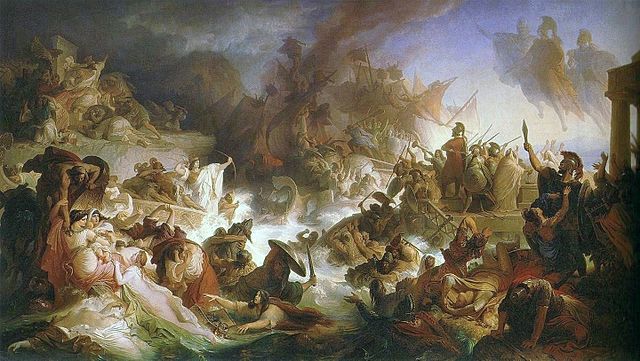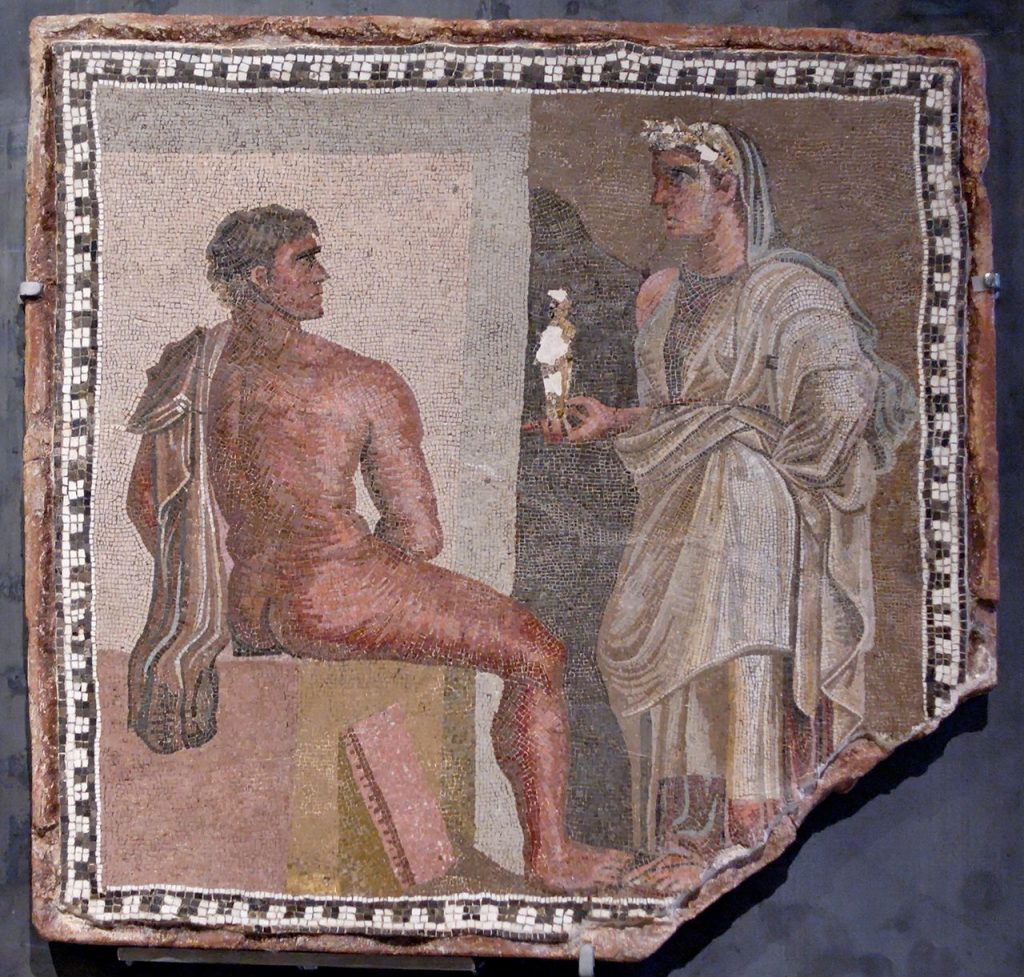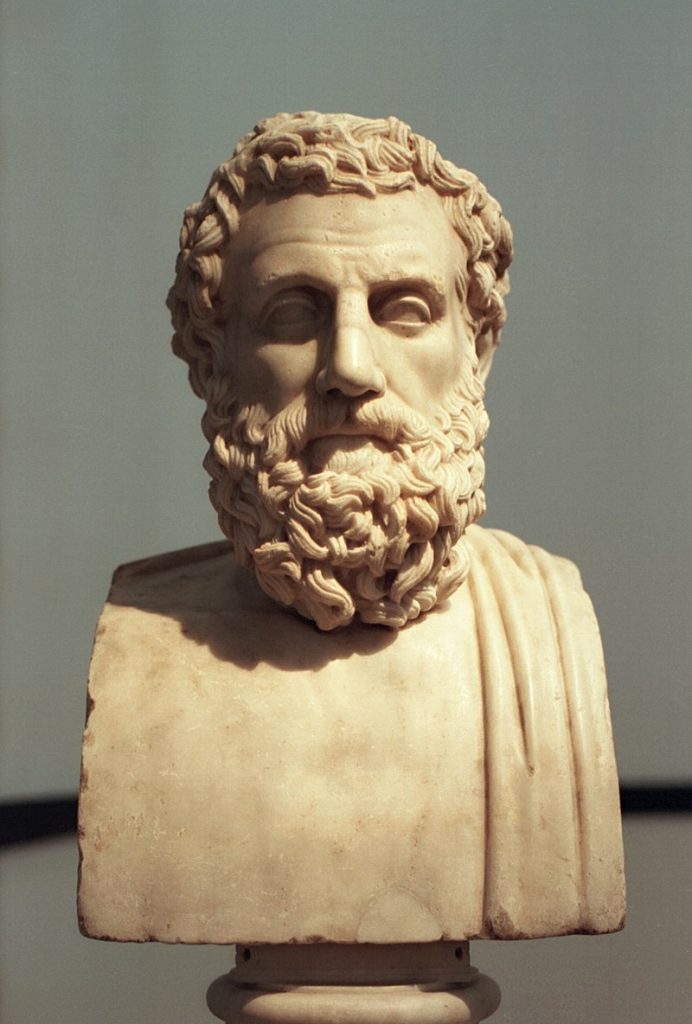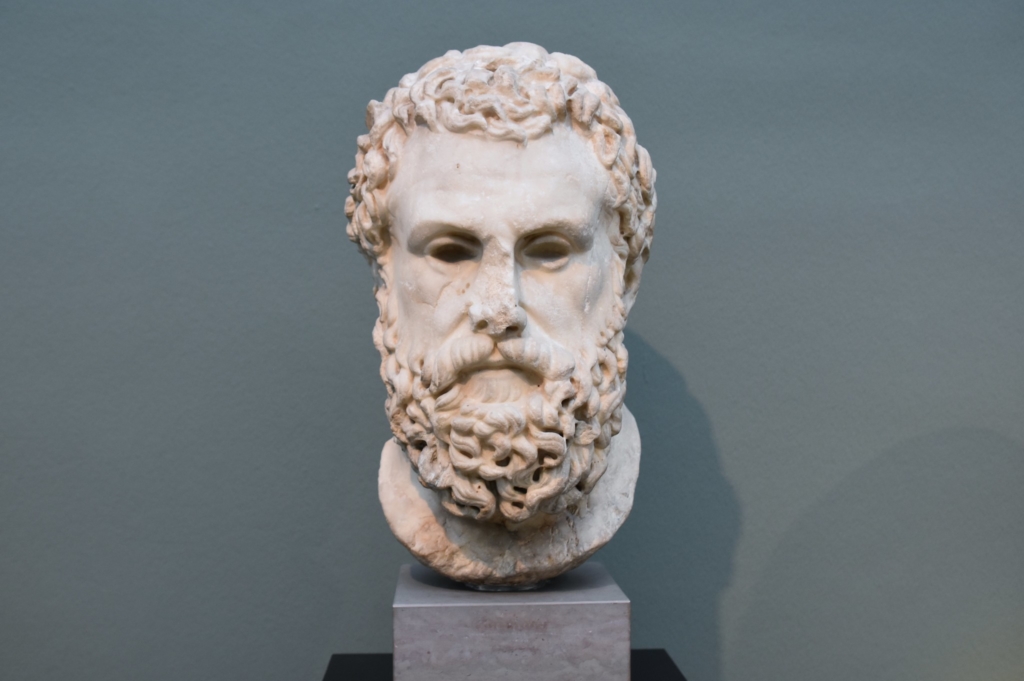Written By Walter Borden, M.D., Contributing Writer, Classical Wisdom
Aeschylus speaks to me. Born in Eleusis, a village just north of Athens and the haunting grounds of the goddess Demeter, said to be the goddess of fertility and the harvest. To Aeschylus that was just a myth that masked her true identity—the goddess of grief. When he was a little boy crying at the grave of his grandfather, she’d whispered to him that his sadness and tears would make the soil rich, would bring new life to sprout.
Only the citizens of Eleusis were aware of Demeter’s real meaning—and mission. She’d lost her daughter, Persephone, to a plague, but Demeter felt it as a robbery—her baby stolen by a death she called Hades, god of the underworld. He was the evil of ancient times. She vowed to find her daughter, bring her back, to her arms, to life.
The citizens of Eleusis were sworn to secrecy, never to reveal her grief—it was too agonizing. Their oath of secrecy became the cult of the “Eleusinian Mysteries.”
As a citizen of Eleusis, Aeschylus knew all that, but he revealed the secret of the mysteries in one of his early poems. For breaking the oath of secrecy he was prosecuted for heresy in an Athenian court under a system of public democratic justice, established by Solon some hundred years prior. Aeschylus was found not guilty. The jury decided that grief outweighed guilt. After experiencing Athenian justice personally, he became its powerful spokesperson.

Having killed his mother, Orestes is Pursued by the Furies, by William-Adolphe Bouguereau
Aeschylus later gave Persephone’s mysterious death his creative twist. Plague and death were thought to be a calamity wrought by the gods. The popular explanation was that Hades, the god of the underworld, abducted Persephone. Aeschylus thought this was the storybook way of saying the girl’s dying must have a sinister, but purposeful source. Indeed, even today, do we not explain senseless tragedy by attributing it to evil? Aeschylus said that people blamed the gods when something inexplainable happened. Did it simply mean that to lose someone really close was bad, and could make you feel bad?
In his metaphorical dramatic interpretation, Demeter and Persephone couldn’t accept losing each other. Their bond was so strong; grief endured and lashed them together. They pined, persisted, persevered, and then—a miracle. Their grief-bond seemed to ferment and come alive in a new form. New life sprouted. They called it Spring, the time of fertility. Followed by a time of growth, Summer, and then harvest, Autumn. Cold set in, snow. Winter, the earth rested waiting for the return of Spring. The seasons came to be, cycles of life and death. The “Mystery?” It’s about fertile grief, how grief can bring new life.
Aeschylus’ best writing germinated in his personal tragedy on the plains of Marathon fighting the Persians. He saw his beloved brother, Koryenous, hacked to death by the Persians. He suffered grief which fermented—metabolized—blossomed (sprouted if you will) in his drama.

Die Seeschlacht bei Salamis [English: Battle of Salamis], Wilhelm von Kaulbach, 1868.
In 510 BCE, when Aeschylus was fifteen, the tyrant Pisistratus fell and Cleisthenes came to power, instituting a constitution that was the culmination of the movement toward democracy that had begun with Solon a hundred years earlier. Greece and Aeschylus were both in their adolescence, filled with idealism, energy, and enthusiasm. It was a time of hope. Then came attacks by Persia, and the beginning of Aeschylus’s personal suffering. His prime work was conceived after his brother’s death in the Battle of Marathon in 490 BCE. From the bitter sweet victory mixed with his brother’s blood came a passion to find non-violent ways to solve conflict. He knew the need for a system of justice to replace vengeful violence which then became a major theme in his work.
Of his ninety plays, only seven survived. They are all we have of his work, and there is controversy as to when each was written, except the first and the last. The Oresteia was produced in 458 BCE, two years before his death. The first was probably The Persians, the only non-mythological play, written shortly after the Battle of Salamis, in 480 BCE.
Aeschylus’s profound insight was the importance of freedom to speak one’s mind, as a generality, but especially in expressing the pain of loss, that unspoken grief is unresolved grief that can become madness and murderous retaliatory rage, breeding more violence. He is said to have observed that words are like a physician to the mind gone mad. From his own life and personal pain, in the Oresteia, he created a tragic drama that touched the deep need for psychological healing in a people that had experienced overwhelming losses from terrible wars, plagues, cycles of retaliatory violence, and the impact of social changes as the Bronze Age gave way to early modern civilization.

Mosaic of Orestes, main character in Aeschylus’s only surviving trilogy, the Oresteia
Aeschylus was the first tragedian, but also soldier, democrat, social critic, psychologist, and philosopher. Called the religious or moral tragic dramatist because of his focus on crime and punishment and on personal responsibility for destructive behavior, he could more accurately be described as a psychologist of conscience.
As a dramatist of crime and punishment, he was the first to stage a courtroom scene, and he knew personally what it meant to be wrongly accused, since he had been charged with heresy for revealing the secrets of the mystical Eleusis, later vindicated in a law court. His genius combined psychology and sociology in the context of historical development, reinforcing his message with the arts of dramaturgy, staging, poetry, music, and choreography. He marketed justice with appeal to the senses as well as the mind.
There is very little known of a biographical nature except that his father, Euphorion, came from an old aristocratic family in Eleusis, near Athens. Of his two sons one became a dramatist. His sister was the matriarch of a dynasty of tragic dramatists. The lineage raises interesting questions about this family who wrote with so much insight about the importance of relationships and family issues.

Ruins at Eleusis, Greece. © Emmanouil Pavlis/Dreamstime.com
Although the women were invisible, Aeschylus’s sister could not have been an inconsequential person, and her brother’s work portrays some very strong female characters. Athena, who speaks for Aeschylus in the Oresteia, is the play’s most powerful figure, overshadowing Zeus and Apollo. The injustice to women in Greek society and its destructive impact on them and the community is the theme of his Suppliants and a subtheme in the Oresteia.
As an adolescent, he lived through the overthrow of Pisistratus, the murder of the latter’s son Hipparchus, and the establishment of the democratic constitution of Cleisthenes. It was a turbulent time: Persia was mobilizing to attack Attica, the Athenian heartland. Aeschylus became a soldier and fought in the infantry at Marathon and Salamis. The Persians was produced ten years after Marathon and immediately after the victory at Salamis. The Oresteia and Seven Against Thebes are strongly antiwar, and the themes of war’s waste of innocent lives and unresolved grief resonate throughout. In The Persians, he dramatizes the Greek victory as a mastering of a savage hubris latent within the victors. He also attacked the glorification of war in the Athenian celebration of the victory over Persia.
Until Aeschylus, drama was two-dimensional. In the ancient epic/lyric form, there is one actor, the hero, and the chorus, which represents some facet of the voice of humanity. The hero is defined, and engulfed, by external forces that grow stronger as he struggles against them. The character of the hero is almost irrelevant; he is pushed and pulled by destiny’s demons. The chorus, a communal voice with a character of its own, is the protagonist and defines the issues—usually grand communal themes, such as the polis, the defeated and/or the victimized—by focusing them on the single actor through a prism of moral force. Chorus and actor are in reciprocal relation.

The Murder of Agamemnon by Pierre-Narcisse Guérin (1817)
As the crisis develops and tension builds, the focus shifts. The actor becomes protagonist, the center of the moral struggle, which ends with the hero facing the crisis and making his decision. In the lyric epic, the initial situation never changes. The plot remains the same as in the first ode, when the actor enters and reveals the general situation. There is no moving plot. The only action is the increasing tension within the hero. There is no way to change perspective.
In a creative leap, Aeschylus adds a second actor, which brings movement to the plot and shifts the focus onto character. The second actor introduces new information, such as relevant events that would be impossible for the hero to know, events that may drastically change his circumstances. An old family employee can come onstage with news that the hero’s wife is really his mother, or a messenger arrives to tell him that the presumed dead son is alive and has returned with murder in his heart, or that the opponent he is going to fight to the death is really his brother. The plot moves and thickens. Moreover, interactions between characters add definition and dimension to their development.
In another creative leap, he modified the structure of the trilogy, linking three plays in a series with a unified theme. The concept of linked acts—action over time with continuity of motif—enables evolution of plot and issues associated with the generation of inner drama in the hero. Trilogy, as used by Aeschylus, can best be understood as the ancestor of the three-act play.

Electra and Orestes at the grave of Agamemnon. Greek tragedy by Sophocles. ©Ronald Sheridan/Ancient Art & Architecture Collection
Using this structure, he was able to portray the transfer of influences from person to person, generation to generation, within a family and within a people. Change, growth, and decline was brought to life on the stage. He could dramatize the legacy of emotions—a sense of obligation, a sense of guilt—that passed from fathers to sons and daughters and on to future generations. He could depict the harbingers of madness and the long-term effects of grief, abuse, conflict, and violence—thus showing that retaliatory violence, even in the name of justice, only breeds more violence, that oppression of women and children makes them violent in turn, that brutality is destructive to society. He was able to show that unspoken grief results in an inability to come to terms with the past and leads to the reenactment and perpetuation of old conflict and pain. His dramas are the first psychiatric studies.
Aeschylus helped lay the foundation of psychodynamic psychology. He was also a consummate advocate for the incorporation of psychological understanding in democratic justice. He dealt with the issue of criminal responsibility when madness is an element of criminal behavior. Guilt had deep roots in Hellenic culture, stemming from the primitive conviction that the gods—Zeus in particular—would take revenge on any mortal who offended them. In Homer’s time, guilt was associated with the anger of the gods; extenuating circumstances and motivation were irrelevant; psychological issues were irrelevant. Only the act counted, and punishment was absolute. The Furies were the gods of vengeful punishment and could drive the offending mortal to ate, guilt-ridden madness.

Orestes at Delphi, flanked by Athena and Pylades, among the Erinyes and priestesses of the oracle. Paestan red-figure bell-krater, c. 330 BC.
As psychological understanding evolved, ate was seen as arising within the human mind rather than having been put there by the gods. Furthermore, guilt—and by extension, depression—was seen as impairing thinking and judgment. The orator and legislator Lycurgus (390-324 B.C.), in Against Leocrates, quotes an unnamed poet:
“When the anger of the demons is injuring a man, the first thing is that it takes the good understanding out of his mind and turns him to the worse judgment, so that he may not be aware of his own errors.”
Aeschylus refined this notion into the theory that the guilty could unknowingly seek punishment. Guilt and despair were not seen as visitations from the gods but as an internalized sense of wrongdoing that could rise to the level of ate─that is, reach such intensity that it became insanity.
There are crimes that arise from a sense of guilt, and some criminal behavior is a seeking of punishment. While Solon planted the seeds of psychology in justice; Aeschylus cultivated and helped shape the growth, giving clear and dramatic power to a basic element buried in Solon’s legal code: that the substance of justice includes humanism—that is, compassion, mercy, respect for the person, for the rights of the weak, and at the same time dispassionate psychological understanding.
The transformation of the passion for retaliatory violence into a higher order, a system of rational justice, began in the seventh century BCE and was institutionalized by Solon in the sixth century. Aeschylus dramatized this transformation in the fifth century, distilling and refining the psychological elements of Solon’s justice, giving them a powerful voice. Solon separated theology from the administration of justice for the first time in human history, and took the gods out of the law.

Roman marble herma of Aeschylus dating to c. 30 BC, based on an earlier bronze Greek herma, dating to around 340-320 BC
Aeschylus used the gods as symbols; his religion is secular, reflecting the evolution of the theology founded on Zeus’s law, “to the doer be done”—the Greek equivalent of the Hebrew “eye for an eye”—into a new institution of justice and a moral code based on human psychology. In the Oresteia, Zeus, Furies, and Apollo are symbols of the old order; Athena is the new; they are clearly dramatic symbols, not to be seen as real deities. As Solon had done with his legal code, Aeschylus dramatically brought the laws of Olympus down to Earth so that they could be seen inside men and women, understood, and elaborated in a system of public justice.
He dramatized the development of mature conscience and its relationship with law. The gods do not direct human actions; the direction comes from within. The individual, not the gods, bears all responsibility, but responsibility is not absolute, as under Zeus’s law, nor should punishment be absolute. The mature sense of responsibility, conscience, is rational—meaning actions directed toward others are determined by reason and empathy tempered by values.
Aeschylus dramatically portrayed the transition of values from gods to parents and the identification with those values within the family. Empathy and parental identification are at the core of a rational sense of right and wrong and the ability to anticipate causing harm. Rationality also means that all relevant circumstances have to be considered, and that there are degrees of responsibility. Circumstances, such as chance, accident, motivations, intent, harm done, and psychological understanding are factored into the equation that the mature rational mind uses in assessing guilt. There are degrees of guilt, and punishment should be proportional. These conditions are integrated in the rational sense of responsibility called conscience. While for the most part conscience and law coincide, they may differ, and even conflict. That is the stuff of tragedy, too, and Aeschylus is its master.


















2 comments
Why only seven plays extant? Were the remainder burned at the Alexandria Library? If they did make it to Persia, did their Scholars not appreciate the plays and disposed of them? Did the new Christian power base just destroy all the copies?
Cecil R. Williams
He lived in an interesting time where people have separated the ‘gods’ from law and justice and that that more than 2000 years later we still have to struggle to keep myth out of law…
Myths like ‘race’ and even gods are still in the way of important aspects of life becoming completely secular, as they are supposed to be…
Our apologies, you must be logged in to post a comment.